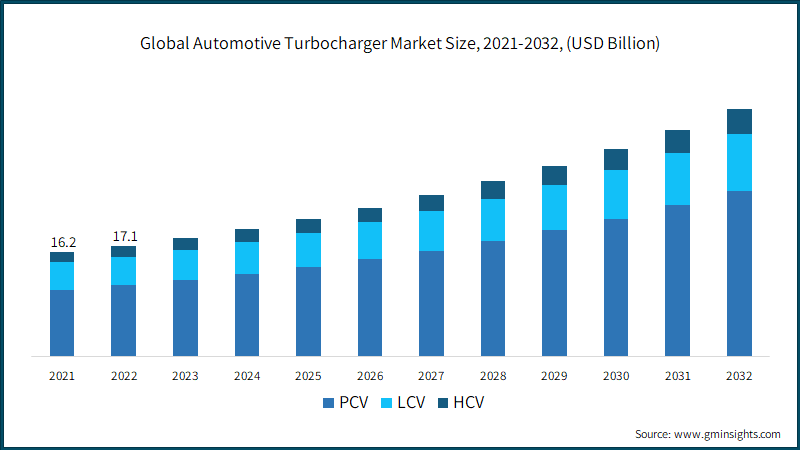Home > Automotive > Automotive Parts > Transmission and Drivetrain > Automotive Turbocharger Market
Automotive Turbocharger Market Analysis
- Report ID: GMI2463
- Published Date: Dec 2022
- Report Format: PDF
Automotive Turbocharger Market Analysis
Automotive turbocharger market valuation from the PCV vehicle segment is anticipated to surpass USD 25.6 billion by 2032. In recent years, the production of premium PCVs has increased dynamically due to the growing demand for luxury vehicles in high-income countries such as the U.S., UAE, Germany, and China. For instance, in the U.S., luxury car sales have been increasing steadily with more than 35% surge in sales of super-premium cars such as Bentleys, Ferraris, and Lamborghinis over the last five years. Moreover, premium vehicle brands such as Audi AG, Mercedes-Benz, and BMW AG are ramping up investments to support R&D activities for the development of state-of-the-art turbocharger systems with superior efficiency.

The twin turbo technology segment in the automotive turbocharger market accounted for more than USD 4.8 billion in 2022 owing to the deployment of strict emission reduction targets and stringent government norms. These types of turbochargers offer superior performance capabilities allowing exhaust gases to be recycled. A parallelly setup twin turbo system offers efficient packaging inside the engine bay with the least amount of exhaust piping required. They also allow engine manufacturers to use small-sized turbos and eliminate the turbo lag linked with larger systems. The increasing need for cost-effective engine solutions will propel the demand for twin turbos.
In terms of volume, the gasoline automotive turbochargers is poised to reach approximately 33 million units by 2032. Gasoline-powered engines and turbochargers continue to have significant manufacturing as well as customer preference on account of their high RPM capabilities in passenger vehicles. Since petrol is more combustible than diesel, turbochargers with petrol engines can effectively enhance engine power notably. Petrol turbos are smaller and lighter systems that are capable of running at a relatively higher RPM range with a greater boost in pressure. Hence, as compared to diesel turbos, petrol counterparts facilitate faster functioning.
Automotive turbocharger market from the OEM segment is expected to witness over 8% growth rate between 2023 and 2032. OEMs are among the largest distributors of automotive turbochargers impelled by the pre-installation of these systems in vehicles. Automotive manufacturers worldwide are rapidly integrating next-generation technologies in passenger and commercial vehicles for improved customer experience, fuel efficiency, fuel economy, and overall performance. Additionally, OEMs are focusing on energy-efficient systems to reduce their overall carbon footprint and comply with ambitious targets pertaining to the reduction of greenhouse gases. This scenario represents lucrative business prospects for turbocharger manufacturers.

Europe automotive turbocharger market size is slated to exhibit nearly 7% gains through 2032. Europe is home to leading automobile manufacturers, subsequently fuelling the regional automotive turbocharger business. Due to the favorable footprint of automakers, the region is experiencing notable growth in R&D activities and investments in the field of new turbocharger technologies. In addition, several foreign automobile manufacturers are investing in the EU to expand their business. For instance, in June 2022, Tata Technologies unveiled its new European Innovation & Development Centre (EIDC) in Warwick, U.K.

